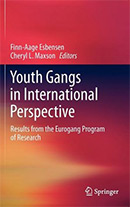Youth Gangs in International Perspective: Results from the Eurogang Program of Research

Finn-Aage Esbensen and Cheryl Maxson, editors
New York: Springer, 2012. 319p.
Reviewer: James C. Howell | July 2012
This book will be of interest to scholars who are pursuing a broader understanding of gangs around the world. This is the fourth edited book produced by the Eurogang research network since its establishment in 1997 to engage European and American gang researchers in collaborative work. Although an expensive one ($179.00 new), it is worth the price for gang researchers with international interests. Three impressive edited books have been published by the Eurogang network in the past decade. The first one, organized by Klein, Kerner, Maxson, and Weitekampf (2001), explores known gang problems in Europe. In the second volume, Decker and Weerman (2005) present studies in six European countries (the Netherlands, Germany, Russia, Scotland, Italy, Norway) and Scandinavia. The third volume—on street gangs, migration, and ethnicity (Van Gemert, Peterson, & Lien, 2008) —features compiled papers from the Eurogang program’s first thematic focus on multiethnic gang issues. The present volume features studies of group processes while also addressing definitional issues and research methods.
U.S. gang researchers fully empathize with European scholars as they grapple with American conceptualizations of gangs in the arduous task of defining their own groups. To be sure, gang validation is a very vexing problem in the U.S., even though gangs are far more established on this side of the pond. Some criminologists (Sullivan, 2005) refuse to acknowledge gangs that many gang scholars would recognize, and others deny the robust correlation between gangs and elevated crime (Katz & Jackson-Jacobs, 2004).
Authors in this latest book from the Eurogang research network gallantly wrestle with the conundrum that resulted from the decision its members made early on to allow groups to be acknowledged as “gangs” even though the members themselves might not identify their group as one. This exception was based on concern that many street groups in Europe bearing some resemblance to stereotypical American gangs are qualitatively different and should not be called “gangs.” By consensus, the Eurogang Network eventually settled on this definition: “A street gang (or troublesome youth group corresponding to a street gang elsewhere), is any durable, street-oriented youth group whose involvement in illegal activity is part of its group identity” (Esbensen and Maxson, chapter 1, p. 6). In other words, “troublesome youth group” could be substituted for the gang term. This compromise further complicated the European studies because researchers studying troublesome youth groups could not use the most robust indicator of a gang member (self-identification by asking youth “Are you a gang member?”). Unfortunately, each of these decisions opened the door more widely to non-gang delinquent groups.
In chapter 2 of this volume (Matsuda and colleagues), a comparison of three methods for classifying gangs in a 7-city U.S. sample of adolescents revealed that the Eurogang definition classified more than twice as many youth as gang members than either the self-nomination method or asking youth if their friends are in a gang. It is apparent that the looser Eurogang definition snares a subset of traditional delinquent groups (Warr, 2002) or social networks (Fleisher, 2006; Sarnecki, 2001). Miller (1982/1992) empirically categorized comparable “law-violating youth groups” across multiple cities in a 26-city U.S. study carried out in the late 1970s. He identified 20 such groups, only three of which were gangs: turf gangs, gain-oriented gangs, and fighting gangs. The 17 remaining law-violating youth groups included burglary rings, theft cliques, robbery bands, extortion cliques, drug-dealing cliques and networks, assaultive cliques, and others. Several of the gangs described in this volume bear close resemblance to the numerous law-violating youth groups and networks found in any country.
Now, after more than a decade of Eurogang Network research, its founder, Malcolm Klein (chapter 17, p. 293), implores his colleagues that “clarity is needed not only on what is a street gang but also how we define gang members and gang-related crime” to resolve the validity problem. Two suggestions come to mind. First, requiring a name should help distinguish actual gangs from the many other law–violating youth groups. Bjerregaard (2002) insists that this the most potent criterion for defining gangs. Her position is buttressed by a nationwide U.S. survey data showing that having a name is a main indicator of gang presence—one that 8 in 10 U.S. students use—along with spending time with other members of the gang (Howell & Lynch, 2000). Other criteria used by more than half of all students are wearing clothing or other symbols that identify their gang membership, tagging or marking turf, and committing violent acts.
A second option that should help to add validity to the Eurogang definitions is the addition of a more stringent minimum size criterion to distinguish gang members. At present, the Eurogang definition “captured youth that had a group of friends that fit the following criteria: (1) had three or more people, (2) with people mostly between the ages of 12 and 25, (3) that spends a lot of time in public places, (4) been in existence for more than 3 months, and (5) accepted and actually participated in illegal activity” (Matsuda and colleagues, chapter 2, p. 23). A higher standard of five members is concordant with extensive research on adolescent groups which finds that typical sizes of delinquent groups range from two to four members, and that the number of active participants tends to diminish in late childhood and early adolescence to triads and dyads in middle and late adolescence (Warr, 2002). Hence a standard of five members should winnow out most very small friendship groups and cliques that are actively involved in delinquency and help improve the validity of “gang member” classification using the Eurogang definition.
On another important front in the Eurogang research, Esbensen and Maxson (chapter 18) encourage continuing attention to group processes associated with gang violence. This observation is important, given the prospect of gang expansion in Europe suggested in several of the recent network publications (Van Gemert and colleagues, 2008). Thwarting gang violence could well become more a priority (Decker & Pyrooz, 2010; Klein, Weerman, & Thornberry, 2006). Seminal research on U.S. gangs may be helpful in this regard. The earliest gangs in this country emerged from imperfect social, cultural, political, and economic conditions that led to serious conflicts among racial, ethnic, and criminal groups in the streets (Howell, 2012, pp. 1-27). Hence, social disorganization theory continues to enjoy strong empirical support as macro-level explanation of gang presence, and also serious gang violence. Short and Strodtbeck (1965) identified “status threats” as a precipitating factor for gang violence. In a later analysis of the Chicago study data, Hughes and Short (2005) identified the main dispute pretexts that precipitated violence, mainly retaliations (55%), identity attacks (36%), and normative or order violations (31%). Miller (1966) documented the prevalence of collective engagement of different gangs, accounting for a third of person-driven violence. In the early 1990s Block and Block (1993) isolated several circumstances that produce “peaks and valleys” in homicides and other violence. Soon thereafter, Decker (1996) documented a series of escalating and de-escalating stages that create a feedback loop where each killing requires a new killing. Fleisher (2006) insists that it makes more sense to view gangs as embedded in social networks, often with members of other gangs and nongang youths alike. Along this line, Papachristos (2009) found that murders spread in the neighborhood through a process of social contagion as gangs respond to threats from other gangs. “Gang members come and go, but their patterns of behavior create a network structure that persists and may very well provide the conduit through which gang values, norms, and culture are transmitted to future generations” (p. 119). Tita, Cohen, and Endberg (2005) identified the location of gang set spaces with the help of gang’s members. Violent hot spots and gang turf often co-occur, and these neighborhood placesare seen as having criminal trajectoriesin their own right (Griffiths & Chavez, 2004). These are rich contributions to understanding group processes in U.S. gang culture and there are more in the large body of gang literature that has emerged over the past half century. These varied constructions may be of some value to European scholars and practitioners in urban areas where gangs are particularly violent.
Readers should be advised that four chapters in this volume are not specifically Eurogang studies. Although a very important contribution to international gang literature, chapter 6 reports a comparison of gangs in Phoenix, AZ and the Republic of Trinidad and Tobago. In chapter 7, Maxson makes an incredulous attempt to apply the broad Eurogang definition to regimented gangs in a California youth prison; any broad definition will apply to more generic cases. Chapter 8 contains a secondary report on an earlier California study of youth perceptions of gang injunctions that are so widely used in that state but not in Europe. Melde and Esbensen (chapter 10) report their test of Laub and Sampson’s “turning point” concept, which evidences relatively strong support.
Hopefully the Eurogang Network will test gang theories that that are more relevant to the psychosocial risk factors that contribute to gang joining and related violence, given the embryonic state of many gangs in that region. With roots in social disorganization theories, Vigil’s (2008) “multiple marginality” thesis is widely recognized as a valid explanation of gang joining—and also gang formation, particularly when coupled with findings from the important French study revealing emergence of gangs from punished and alienated students in “difficult” schools (Debarbieux & Baya, 2008). Understandably, Vigil’s theory enjoys considerable currency in Europe. The field of developmental criminology has provided the most fully validated theory of gang joining, an interactional theory created by Thornberry and colleagues (2003). It subsequently was extended downward to encompass antecedents of gang membership from birth through early adolescence (Howell & Egley, 2005; Howell, 2012). Alleyne and Wood adeptly test this gang theory (chapter 9; see also Wood & Alleyne, 2010 and a forthcoming article in Crime and Delinquency). Studies in multiple cities undertaken by independent researchers confirm that gang involvement is a result of problem behaviors in multiple developmental domains (Alleyne and Wood, this volume; Hill and colleagues, 1999; Esbensen and colleagues, 2010; Thornberry and colleagues, 2003).
In closing this review, I would be remiss if I neglected to pay tribute to the Eurogang network scholars. Their accomplishments in the past decade are most salutary and this book is further testimony to the excellent contributions they are making toward understanding gangs around the world, especially in drawing distinctions between fabled American gangs and European street groups that do not match up. The plethoras of insights the assembled scholars provide are of enormous value in the ever-growing gang literature. I offer two sobering reminders that I hope will give them comfort from the pains associated with categorizing gangs and other marginal groups. First, in many instances, youth in U.S. gangs can neither define a “gang” nor name all of the current members of their own gang. Second, “no two gangs are alike, and they change constantly in membership, structure, and behavior; new gangs are formed and old ones fade away or merge with others. They do not sit still to be examined under a microscope, or by any other method devised by researchers. When we study them, whether by observation, interviews, administering questionnaires and other research instruments, or by arrest rates, the best we can hope for are snapshots at a given time or over a period of time” (Short & Hughes, 2009, p. 406).
References
Bjerregaard, B. (2002). Self-definitions of gang membership and involvement in delinquent activities. Youth and Society, 34, 31–54.
Block, C. R., & Block, R. (1993). Street gang crime in Chicago. Research in Brief. Washington, DC: U.S. Department of Justice, National Institute of Justice.
Debarbieux, E., & Baya, C. (2008). An interactive construction of gangs and ethnicity: The role of school segregation in France. In F. van Gemert, D. Peterson, & I.-L. Lien (Eds.), Street gangs, migration and ethnicity (pp. 211–226). Portland, OR: Willan Publishing.
Decker, S. H. (1996). Deviant homicide: A new look at the role of motives and victim-offender relationships. Journal of Research in Crime and Delinquency, 33, 427–449.
Decker, S. H., & Pyrooz, D. C. (2010). Gang violence worldwide: Context, culture, and country. Small Arms Survey 2010. Geneva, Switzerland: Small Arms Survey.
Decker, S. H., & Weerman, F. E. (Eds.). (2005). European street gangs and troublesome youth groups. Lanham, MD: AltaMira Press.
Esbensen, F., Peterson, D., Taylor, T. J., & Freng, A. (2010). Youth violence: Sex and race differences in offending, victimization, and gang membership. Philadelphia: Temple University Press.
Esbensen, F., Peterson, D., Taylor, T. J., Freng, A., Osgood, D. W., Carson, D. C., & Matsuda, K. N. (2011). Evaluation and evolution of the Gang Resistance Education and Training (G.R.E.A.T.) program. Journal of School Violence, 10, 53–70.
Fleisher, M. S. (2006). Youth gang social dynamics and social network analysis: Applying degree centrality measures to assess the nature of gang boundaries. In J. F. Short & L. A. Hughes (Eds.), Studying youth gangs (pp. 86–99). Lanham, MD: AltaMira Press.
Griffiths, E., & Chavez, J. M. (2004). Communities, street guns and homicide trajectories in Chicago, 1980–1995: Merging methods for examining homicide trends across space and time. Criminology, 42, 941–975.
Hill, K. G., Howell, J. C., Hawkins, J. D., & Battin-Pearson, S. R. (1999). Childhood risk factors for adolescent gang membership: Results from the Seattle Social Development Project. Journal of Research in Crime and Delinquency, 36, 300–322.
Howell, J. C. (2010). Gang prevention: An overview of current research and programs. Juvenile Justice Bulletin. Washington, DC: U.S. Department of Justice, Office of Juvenile Justice and Delinquency Prevention.
Howell, J. C. (2012). Gangs in America’s Communities. Thousand Oaks, CA: Sage Publications.
Howell, J. C., & Egley, A., Jr. (2005). Moving risk factors into developmental theories of gang membership. Youth Violence and Juvenile Justice, 3, 334–354.
Howell, J. C., & Lynch, J. (2000). Youth gangs in schools. Juvenile Justice Bulletin. Youth Gang Series. Washington, DC: U.S. Department of Justice, Office of Juvenile Justice and Delinquency Prevention.
Hughes, L. A., & Short, J. F. (2005). Disputes involving gang members: Micro-social contexts. Criminology, 43,43–76.
Katz, J., & Jackson-Jacobs, C. (2004). The criminologists’ gang. In C. Sumner (Ed.), The Blackwell companion to criminology (pp. 91–124). Malden, MA: Blackwell.
Klein, M. W., Kerner, H., Maxson, C. L., & Weitekampf, E. (Eds.). (2001). The Eurogang paradox: Street gangs and youth groups in the U.S. and Europe. Amsterdam: Kluwer Academic Publishers.
Klein, M. W., Weerman, F. M., & Thornberry, T. P. (2006). Street gang violence in Europe. European Journal of Criminology, 3, 413–437.
Miller, W. B. (1966). Violent crimes in city gangs. The Annals of the American Academy of Political and Social Science, 364, 96–112.
Miller, W. B. (1982/1992). Crime by youth gangs and groups in the United States. Washington, DC: U.S. Department of Justice, Office of Juvenile Justice and Delinquency Prevention.
National Gang Center. (2010). Best practices to address community gang problems: OJJDP’s Comprehensive Gang Model. Washington, DC: Author.
Papachristos, A. V. (2009). Murder by structure: Dominance relations and the social structure of gang homicide. American Journal of Sociology, 115, 74–128.
Sarnecki, J. (2001). Delinquent Networks: Youth Co-Offending in Stockholm. Cambridge, UK : Cambridge University Press.
Short, J. F., Jr. & Hughes, L. A. (2009). Urban ethnography and research integrity: Empirical and theoretical dimensions. Ethnography, 10, 397–415.
Short, J. F., Jr., & Strodtbeck, F. L. (1965/1974). Group process and gang delinquency. Chicago: University of Chicago Press.
Specht, W. (2010). Mobile Youth Work in the Global Context: Reaching the Unreachable. Series of the International Society for Mobile Youth Work. Tübingen, Germany: International Society for Mobile Youth Work, University of Tübingen.
Sullivan, M. L. (2005). Maybe we shouldn’t study “gangs”: Does reification obscure youth violence? Journal of Contemporary Criminal Justice, 21, 170–190.
Thornberry, T. P., Krohn, M. D., Lizotte, A. J., Smith, C. A., & Tobin, K. (2003). Gangs and delinquency in developmental perspective. New York: Cambridge University Press.
Tita, G. E., Cohen, J., & Endberg, J. (2005). An ecological study of the location of gang “set space.” Social Problems, 52,272–299.
Van Gemert, F., Peterson, D., & Lien, I.-L. (Eds.). (2008). Street gangs, migration and ethnicity. Portland, OR: Willan Publishing.
Vigil, J. D. (2008). Mexican migrants in gangs: A second-generation history. In F. van Gemert, D. Peterson, & I.-L. Lien (Eds.), Street gangs, migration and ethnicity (pp. 49–62). Portland, OR: Willan Publishing.
Warr, M. (2002). Companions in crime: The social aspects of criminal conduct. New York: Cambridge University Press.
Wood, J., & Alleyne, E. (2010). Street gang theory and research: Where are we now and where do we go from here? Aggression and Violent Behavior, 15, 100-111.
James C. Howell is a Senior Research Associate at the National Gang Center


